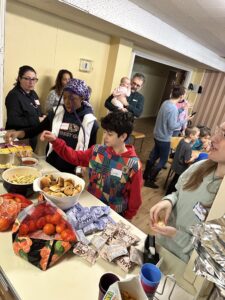All Saints, Dorval
March 24, 2024

The snack counter at Palm Saturday.
One of the funny things about making Holy Week happen is that, alongside all the usual writing and meetings and email and paperwork that typically constitute my job, I also suddenly find myself making long lists of things.
Pastry brushes. Candles. Towels. Speaker. Hard-boiled eggs. Wildflower seeds.
Felt. Incense. Construction paper. Flowers. Dried apricots.
Brazier. Coals. Bowl. Oil. Evergreen branch. Chocolate eggs.
(All 100% genuine, though partial, lists for, respectively, Palm Saturday; the Maundy Thursday youth retreat; and the Great Vigil of Easter.)
Christmas – and especially Christmas pageants – also involve some things, but there’s something about Holy Week that’s uniquely tactile, uniquely rooted in the five senses and in our physical human experience.
And that physicality doesn’t come out of nowhere. It is rooted in the story itself.
A woman came with an alabaster jar of very costly ointment of nard, and she broke open the jar and poured the ointment on his head.
A man carrying a jar of water will meet you.
He took a loaf of bread … he took a cup …
They caught hold of him, but he left the linen cloth and ran off naked.
And they offered him wine mixed with myrrh, but he did not take it.
Then Joseph brought a linen cloth and, taking down the body, wrapped it in the linen cloth and laid it in a tomb that had been hewn out of rock.
At regular intervals, throughout this very complex story, full of ideas and symbolism and warring words, we get these flashes of colour, of texture, of smell and taste. Ointment. Wine. Bread. Water. And those linen cloths, which bookend the Passion with Jesus’ arrest and his death. (And even though Mark’s Gospel begins with Jesus as a grown man, we who have also heard Luke all our lives cannot help hearing in them also a reference to the swaddling clothes that wrapped the newborn Messiah in the manger.)
Holy Week is an immersive, full-body experience. We can talk and think all we want about the whys and wherefores of what God has done and is doing in Jesus Christ, but that is not where the heart of the matter lives. The heart of the matter lives in the smell of split palms and the freezing wind in our faces as we march down the sidewalk singing “Ride on, King Jesus.” It lives in the taste of vegetable soup and matzo at the Maundy Thursday dinner, the feel of lukewarm water and clean towels on our feet, the scent of lilies and incense in the dark chapel at three AM, the rough texture of the cross under our hands and lips during the Good Friday service, the taste of too much wine as we finish off the reserved sacrament, and of course the sensory barrage – flame, water, song, bells – that is the Great Vigil of Easter (and my personal devotional observance, the Handing Out of the Cadbury Mini Eggs During the Postlude).
These experiences bypass the busy thinking brain and go straight to the heart of our humanity, the messy, embodied humanity shared by Jesus of Nazareth and brought to agonized and triumphant completion in the events of this week. We need these sensory impressions to anchor us, because otherwise it would be too much. (In a lot of ways, it still is too much.)
In our flesh, in our senses, is where Jesus meets us and we meet Jesus. These rituals, repeated year by year, peel back our defenses and get at our hearts and our guts.
With the nameless woman, we anoint Jesus; with the man carrying the jar of water, we enter the upper room; with the disciples, we fall asleep under the olive trees; with the young man in the garden, we run away; with Peter, we deny; with Judas, we take the coins; with the soldiers, we mock and jeer; with Simon of Cyrene, we carry the cross; with the bystanders, we offer vinegar on a sponge; with the centurion, we confess; with the women, we stay near; with Joseph of Arimathea, we wrap the body in that linen cloth and lay it in our own tomb.
We are the faithful and the betrayers, the courageous and the cowardly, the watchful and the sleepy, the enemy and the friend.
And as we connect through our senses with those who played their parts in this divine drama two millennia ago, always hovering over our awareness is the infinitely greater – and yet still deeply human – experience of Jesus himself, whose suffering, if we allowed ourselves to feel it fully, would probably break us. Which is why God had to step in and take it on for us instead.
And so, we approach it sideways, in bits and pieces, glimpses, over and over again, year after year, taking into ourselves as much as we can stand of this overwhelming story, this collision of good and evil, of God and the best and worst of humanity, of eternity and time.
Once again, this Palm Sunday, we stand at the start of the path, the path that leads to the cross but does not end there. We meet Jesus in his humanity, in the touch of rough linen cloth, the taste of sour wine, the aroma of ointment in hair, in bread broken and wine poured.
What sight, sound, touch, taste or smell is the one that will anchor you in the story this year? Maybe you know it already and are anticipating it even now. Maybe it will take you completely by surprise. But when it comes, let it fill you, break your heart open, bring you together with your Lord and Saviour, and make you new.
A blessed Holy Week, my friends. Here we go.
Amen.
Leave a Reply